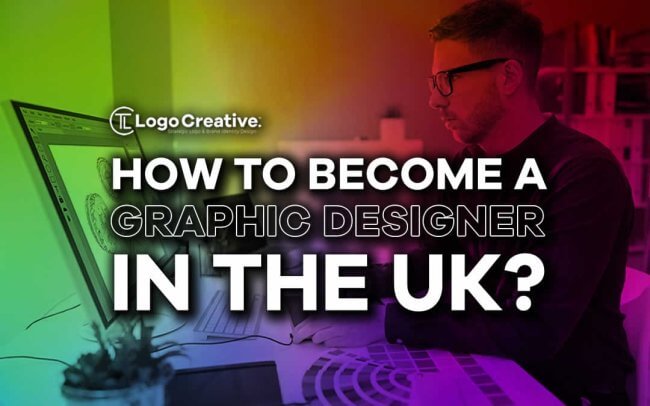In this article we explain How to Become a Graphic Designer in the UK?
When we saw people searching “How to become a graphic designer UK” on Google, we knew that they belong to two categories of people.
The first is those who are training to become graphic designers by themselves, and the second- those who are looking to get a formal qualification
Today, we’re going to talk about how you can pursue both ways to become a graphic designer in the UK.
Table of Contents
What is Graphic Design?

Graphic design is a craft in which experts produce visual content to convey messages. Designers use typography and images to fulfil users’ individual demands and focus on the logic of showing elements.
They show these elements in interactive designs to optimise the user experience by employing visual hierarchy and page layout approaches.
So, in one-word, graphic design processes are all about:
“Moulding the user experience visually”
Graphic Designers
Graphic designers must have design skills and a comprehension of media creation, as well as the ability to answer clients’ needs and come up with new solutions.
They can design and modify images and text in a range of commercial contexts, such as-
- Digital design
- UX design
- Posters
- Motion graphics
- Animation
Graphic designers also employ graphic, sound, visual, and multimedia approaches to deliver a message for information, entertainment, advertising, marketing, or publicity reasons.
A graphic designer will also produce special visual effects and animations for computer games, film, interactive, and other media.
To demonstrate to their clients, the individual will need strong presentation skills as well as knowledge of design trends and technological advancements.
Excellent communication skills are required to manage stakeholders such as photographers, printers, manufacturers, or game developers.
What Does a Graphic Designer Do?

You would utilise your creative ideas and abilities to design the appearance of websites, packaging, advertisements, and other items.
Companies would look to you to create eye-catching designs that would attract more customers.
You could be working on anything from corporate projects with strict design standards to smaller gigs where you can let your imagination run wild.
Typical projects may include a combination of the following:
- Produce or supervise the product that you intend to create.
- Conduct project research, evaluate prior relevant projects and compare the costs of adopting different techniques.
- Calculate the project’s costs.
- Liaise with clients to identify project objectives, discuss media, software, and technology to be used, determine project timelines, and define budgetary restrictions.
- Select the best materials and design.
- Prepare project specifications and instructions for implementation.
- Liaise with other members of the production team to ensure that the graphic design work is compatible with other aspects, methods, and timeframes.
- To create designs, use specialised graphic design software.
- Prepare sketches, scale drawings, models, colour schemes, and other mock-ups for clients to view and discuss any necessary changes.
- Create a final layout with precise typeface, letter size, and colour specs.
- Make sure that budgets and deadlines are met.
What Skills Do They Need?
Hard Skills
Hard skills are distinct, learnable, measurable abilities that are generally industry or occupation-specific.
We’ve listed a set of hard skills that are ranked by the quantity of graphic design job advertisements that specify them as required abilities.
- Adobe Photoshop
- Adobe Illustrator
- Adobe InDesign
- Adobe After Effects
- Animations
- Brand Management
- Typography
- Branding
- Some knowledge of web development and web design
As you can see, the Adobe Creative Suite or Adobe Creative Cloud is an essential skill in graphic design as it is the most widely used tool in the industry.
However, tools like Blender, 3D Studio Max, and Maya also have the same appeal to employers.
Soft Skills
Soft graphic design skills may usually be self-taught, and they do not require a specific level of schooling. Below listed are a set of soft skills that are ranked by the number of job advertisements that specify them as required abilities.
- Effective verbal and written communications
- Creativity
- Problem-solving
- Marketing
- Detail-oriented/Showing attention to detail
- Presentations
- Innovation
- Sales
- Management
- Time management
- Social media
- Brand identity
How to Become a Graphic Designer in the UK?
Self-Trained
If you want to learn graphic design without going to a college or a university, you will need to look at online schools and courses. Alternatively, you can also learn from a mentor.
They will teach you the tools, the creative process etc.
However, most of your soft skills will develop as you gain more experience as you’re not in a classroom environment where there are ways to develop soft skills prior to your employment.
A strong online portfolio to reach out to your potential clients is one of the key points to success here.
Formal Qualification
While a lucky few may be able to secure work as a graphic designer based solely on relevant work experience and a good portfolio, the design industry is primarily comprised of professionals with a degree. As a result, you’ll be expected to have at least an undergraduate degree.
There are two ways to get into this role:
- A college course
- A university course
1. College Course
You may enrol in a college course, such as a Level 2 Technical Award in Graphic Design or A level Graphic Communication, and use this to work as a design assistant for a company.
You would need an excellent portfolio to demonstrate your skills to your potential employers.
Educational Requirements for Entry
- For a level 3 course, 4 or 5 GCSEs at grades 9 to 4 (A* to C), or equivalent.
- 1 or 2 A levels, a level 3 diploma, or suitable experience for a level 4 or level 5 programme are required.
2. University Course
You have the option to take a foundation degree, higher national diploma or degree in a design-related field such as:
- Communication design
- Photography
- Illustration or visual art
- Graphic design
- 3D Design
- Art and design
Having work experience while studying will give you an advantage. Inquire with your university’s career services about work experience, internship, and year placement opportunities, as well as any assistance available to assist you in developing a portfolio.
Educational Requirements for Entry
- 1 or 2 A levels, or equivalent, for a foundation degree or higher national certificate 2 to 3 A levels, or similar, for a degree
Post-Graduation in Graphic Design
Getting a job in graphic design is difficult, especially when you’re competing with other talented graduates. A postgraduate qualification is not required for a career in graphic design, but it can help you stand out from the crowd.
You can apply for a postgraduate loan, as well as scholarships and bursaries, to help pay for your studies. Click here to find out more about postgraduate funding.
Short Courses
Intensive graphic design courses are available at all levels, from beginner to advanced, and are ideal for those who want to learn or advance their skills while working full or part-time.
Apprenticeship
Do your research to see if there are any graphic design apprenticeship possibilities in your area. These are typically offered by large and medium-sized organisations.
Apprenticeships allow you to earn money while learning and are a viable alternative to university studies. If you choose a degree apprenticeship, you will earn a Bachelor’s or Master’s degree while developing your abilities and gaining practical experience. Degree apprenticeships can take anything from one to six years to complete, depending on-
- The nature of your role
- The method you choose to complete your studies
Educational Requirements for Entry
- For an advanced apprenticeship, 5 GCSEs at grades 9 to 4 (A* to C), or equivalent, including English and maths.
What if I Don’t Have Any GCSE?
This is a common question from graphic designers and other people who are involved in creative processes. Well, in that case you can opt for Functional Skills.
Functional Skills courses are better for individuals who want to improve their skills fast (maybe in time for a job), whereas GCSE courses are suitable for people who want to devote more time to their study.
As portfolio and real-life experience is so much more important for designers, this is a great option for them to get into their favourite college, university or to secure an apprenticeship or to get into a job.
“Functional skills are practical skills in English, mathematics and information and communication technology (ICT) that allow individuals to operate confidently, effectively and independently in life and work.”
Department for Education and Skills
The text above from the Department for Education and Skills says it all. Functional Skills are core English, Maths, and ICT (Information and Communication Technology) skills that people utilise on a regular basis in their personal and professional lives; the crucial phrase here is “on a regular basis.” The majority of these skills are so fundamental that they will benefit you in your daily life.
So, you can imagine why if you don’t have any GCSE, you’d have to have Functional Skills to enter the graphic design industry.
Designers, as you’ve read above, need their GCSE to secure a place in a college or university. Apprenticeship requirements are often higher than that of a college- 5 GCSEs at grades 9 to 4 (A* to C), or equivalent, including English and maths.
Functional Skills Level 2 in maths and English conforms to a GCSE level 4 or grade C. Employers and universities accept Functional Skills level 2 qualifications as GCSE equivalents.
Career Path and Progression
The traditional graphic design career path begins as a junior graphic designer in creative industries like a creative design agency, a marketing agency on a large corporation’s in-house design team.
From there, you could aim to become a midweight designer, then a senior designer, an art director, a creative director, and so on.
You may also work as a freelancer or start your own design firm.
Another alternative is to become a teacher or lecturer.
What Experience do You Need as a Graphic Designer?
Internship or placement experience can be incredibly beneficial, especially if you have a reference who can suggest you and provide evidence of your work. Participation in a real project, as well as the creation of a portfolio of your work, provides the most valuable professional experience.
Having your portfolio evaluated while at university might be beneficial because it will allow you to speak confidently about your work, which you will need to do during employment interviews.
The International Society of Typographic Designers (It’s not limited to typographical designers, however) provides a student evaluation scheme. Any experience that allows you to polish your presentation skills will be priceless here.
Alternatively, while studying, you can join the ISTD and the Chartered Society of Designers (CSD). This allows you to network with other designers, which may lead to you learning about career opportunities. Membership also provides events and resources to help you stay up to date on industry trends.
Is a Graphic Design Career Worth Pursuing in the UK?
While we understand that money may not be “end all be all” of life, it is one of the most important aspects. So, let’s show you how much you can expect to make as a graphic designer in the UK.
| Junior graphic designers (Full time, with 0 years’ experience) | Between £18,000 and £23,000 |
| Junior level graphic designers with some experience | Up to £27,000 |
| Senior level graphic designers | £35,000 and £55,000 |
| Creative director | More than £60,000 |
| Freelance graphic designers | Between £200 and £400 per day |
Once you have an amazing track record and referrals, you will be able to charge more. Your residence sometimes also comes in as a factor here. For example, if you’re a designer based in London, you’ll be able to charge more from certain clients, especially major firms and organisations.
Conclusion
Whether you are interested in graphic design as a pastime or as a profession-perhaps as a Marketing or Events manager, the field of graphic design is limitless.
It’s evident from the number of search volumes of the question “How to become a graphic designer UK?” on Google.
Whatever your motivation is for studying graphic design, you will be expanding your personal and professional skillset in a way that is relevant to numerous job descriptions in today’s modern digital world.
Read the blog carefully and see what education and career path suits you the best.
Join The Logo Community
We hope this article abo How to Become a Graphic Designer in the UK? has been helpful. If you would like more personal tips, advice, insights, and access to our community threads and other goodies, join me in our community.
You can comment directly on the posts and have a discussion with Andrew, the Founder of The Logo Creative.
*TIP – We recommend Skillshare to learn online. There are tons of classes for everything including graphic design, web design, marketing, branding and business-related courses. Get a free trial with our link and you won’t regret it Trust us!


